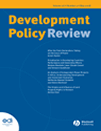‘Safety nets and opportunity ladders: addressing vulnerability and promoting productivity in South Asia’. Development Policy Review Vol. 20 (2): 589-614

As patterns of poverty and vulnerability in South Asia change, households have to balance immediate needs and long–term goals. For the poor, these choices, and the costs of precautionary measures, are particularly acute and call for suitable government policies. While policy–makers face a number of trade–offs between promotion, prevention and protection goals, careful design can maximise the potential to reconcile these objectives. A review of experience suggests a number of lessons regarding the relative benefits of targeted and universal programmes; the need to differentiate microfinance products for different groups amongst the poor; ways of basing the self–targeting of public works on rights rather than stigma; and the influence of political processes (such as decentralisation) for the overall effectiveness of social protection.



